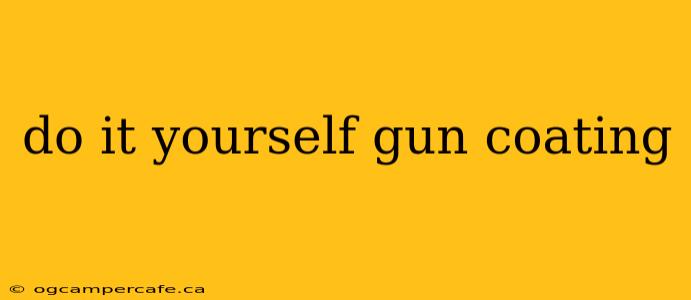Are you looking to upgrade your firearm's finish? DIY gun coating is becoming increasingly popular, offering a cost-effective and customizable alternative to professional services. This comprehensive guide explores the world of DIY gun coating, focusing on Cerakote and other popular options, covering everything from preparation to application and final curing. We'll delve into the necessary tools, techniques, and safety precautions to ensure a professional-looking and durable finish for your firearm.
Choosing the Right Gun Coating: Cerakote vs. Other Options
Several options exist for DIY gun coating, each with its own advantages and disadvantages. Let's compare some of the most popular choices:
Cerakote: The Industry Standard
Cerakote is a ceramic-based coating known for its exceptional durability, resistance to wear and tear, and wide array of colors and finishes. Its hardness and chemical resistance make it a popular choice among firearm enthusiasts. However, Cerakote requires a more meticulous application process and often necessitates the use of a specialized oven for curing.
DuraCoat: A Durable and User-Friendly Alternative
DuraCoat is another popular choice, offering excellent durability at a potentially lower cost than Cerakote. Its application process is generally considered more forgiving for beginners, making it an attractive option for DIY projects. The color selection is also quite extensive, though perhaps not as vast as Cerakote's.
Other Options: Powder Coating and Baked Enamel
Powder coating is a cost-effective option that creates a thick, durable finish. However, it often requires specialized equipment and a powder coating oven, making it less suitable for a complete DIY project in most home environments. Baked enamel offers a simpler application but lacks the same durability as Cerakote or DuraCoat.
Preparing Your Firearm for Coating
Proper preparation is crucial for achieving a flawless finish. This involves several key steps:
1. Disassembly and Cleaning:
Thoroughly disassemble your firearm, removing all components that won't be coated. Clean each part meticulously with a degreaser, ensuring the removal of all oil, grease, and dirt. Use a suitable solvent and brushes to reach all crevices.
2. Surface Preparation:
This step is critical for ensuring proper adhesion. Use fine grit sandpaper (220-400 grit) to lightly smooth the surfaces, removing any imperfections. Pay close attention to removing any rust or pitting. After sanding, thoroughly clean the parts again to remove any dust or debris.
3. Masking:
Use painter's tape and masking materials to protect any areas you don't want coated. This is particularly important for areas with engravings or markings you want to preserve. Take your time and ensure a precise masking job to avoid any unwanted coating.
Applying the Gun Coating: A Step-by-Step Guide
The application process varies slightly depending on the chosen coating, but general principles remain consistent:
1. Ventilation:
Ensure adequate ventilation in your workspace. Use respirators and gloves to protect yourself from fumes.
2. Application Techniques:
Most coatings are applied using an airbrush or spray gun. Practice on scrap metal before applying to your firearm. Thin coats are crucial to avoid runs and drips. Apply multiple thin coats, allowing each to dry before the next application.
3. Curing:
The curing process is critical for achieving a durable finish. Follow the manufacturer's instructions carefully for baking temperatures and times. Incorrect curing can lead to a weak or easily damaged finish.
Safety Precautions: A Must-Read
Always prioritize safety when working with gun coatings and solvents. Here are essential safety precautions:
- Ventilation: Work in a well-ventilated area or use a respirator.
- Eye Protection: Wear safety glasses at all times.
- Gloves: Use appropriate gloves to protect your hands.
- Fire Safety: Be aware of fire hazards associated with solvents and the curing process.
- Proper Disposal: Dispose of solvents and waste materials according to local regulations.
Conclusion: Achieving Professional Results at Home
DIY gun coating can be a rewarding experience, allowing you to customize your firearm's appearance and enhance its durability. By following this guide and prioritizing safety, you can achieve professional-looking results without the expense of professional services. Remember to always consult the manufacturer’s instructions for your chosen coating for specific application and curing procedures. This detailed guide provides a solid foundation, but thorough research and practice are key to success.
